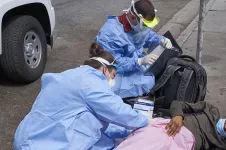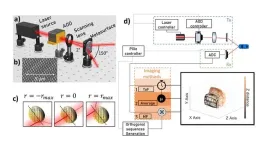(Press-News.org) (Santa Barbara, Calif.) — One of the central challenges for synthetic chemists is to impose control over free radicals. Highly reactive molecules with an unpaired electron, free radicals may be familiar to you; these are the type of molecules we take antioxidant supplements for, in an effort to tame oxidative stress.
In the world of synthetic chemistry, however, free radicals hold a lot of promise.
“Free radical chemistry is very useful for the synthesis of both bioactive small molecules and everyday polymers,” said UC Santa Barbara chemistry professor Yang Yang, an author of a paper on the matter that appears in Nature Catalysis. “However, imposing stereocontrol over free-radical mediated reactions has eluded the asymmetric catalysis community for decades. We’re trying to develop biocatalytic strategies to further push the boundaries of free radical chemistry.”
To fully unlock the synthetic potential of free radicals, Yang and colleagues focus on stereochemistry — also known as 3D chemistry, which focuses on the three-dimensional orientation of atoms and molecules. The stereochemistry of organic molecules has a significant impact on their properties. For example, (S)-carvone or “left-handed” carvone is the primary ingredient that accounts for the distinctive odor of mint. In contrast, (R)-carvone or “right-handed” carvone is found in caraway seeds and has a completely different smell. Thus, to precisely control the stereochemistry is a major goal of synthetic chemistry. To achieve it, chemists turned to catalysts, substances that enable chemical reactions without themselves being consumed or transformed in the process, making them reusable.
Achieving this type of stereocontrol is no small feat. “In general, steering free radicals towards desired stereochemistry is very difficult,” Yang said. Free radicals, once formed, do not interact tightly with the catalyst. Additionally, these radicals are essentially free in another sense — they can quickly wander away from potential reactive sites.
But Yang and collaborators have a few tricks up their sleeves: metalloenzymes — naturally occurring proteins with a reactive metal center, able to generate and rein in those free radicals for selective transformations.
“Specifically in this paper we solve a problem in this field, which is how to control the stereoselective addition of a radical species to an aromatic compound,” Yang said. “The radical in this case is derived from racemic starting material.”
This is where the three-dimensional chemistry comes in. “Racemic” means that the material is composed of equal proportions of “left-handed” and “right-handed” (also known as “chiral”) molecules — asymmetric molecules that are composed of the same atoms, so are chemically identical, but are mirror images of each other. Like your hands, you can match them up reflection-wise, but you can’t superimpose them facing the same way. Which, under normal circumstances, would pose a problem for enzymes.
“Enzymes are widely perceived as very specific catalysts,” Yang said. “If the enzymes are so specific, which happens oftentimes in nature, then the enzyme can only recognize and convert one enantiomeric form of a chiral compound,” Yang said. “And oftentimes the enzyme doesn’t accept its mirror image.
“But in our work,” Yang continued, “we’ve engineered an enzyme that can accept both the left-handed and right-handed form of the starting material, and then convert these starting materials into the same major enantiomeric product with excellent selectivity.”
In their paper, the researchers used an iron-dependent enzyme to produce highly reactive radical species. Through directed evolution, they engineered a set of selective iron enzymes to produce either the left-handed or the right-handed product with excellent selectivity. Furthermore, with a third, “kinetic resolution” enzyme, the researchers can selectively convert the left-handed starting material, leaving the right-handed starting material untouched.
“So we have a toolbox of enzymes to allow for various types of stereocontrol for the radical functionalization of aromatic compounds,” Yang said. “And yet these enzymes only differ from each other by a few mutations.” Yang hopes this growing toolbox of biocatalysts will help others gain better control over their 3D chemistry, a classic problem that continues to face organic chemists.
“Our metalloenzymes provide a potentially general solution to control the selectivities of free radicals,” Yang said. “So these biocatalytic solutions we created will hopefully facilitate the synthesis and study of chiral compounds in academia and industry.”
END
A ‘toolbox of biocatalysts’ improves control over free radicals
2023-07-21
ELSE PRESS RELEASES FROM THIS DATE:
Experts alarmed as free Barbies given to UK primary schools to teach social skills
2023-07-21
Toy company Mattel has been criticised for “stealth marketing” after giving away free Barbie and Ken dolls to schools as part of a programme to teach empathy to children, finds an investigation published by The BMJ today.
Investigative journalist Hristio Boytchev reports that Mattell’s “Barbie School of Friendship” programme, in which free dolls are given for children to carry out role play exercises, has been rolled out to 700 schools across the UK, "with the potential to ...
Impacts of climate change on animals will be “multi-faceted,” study in CABI Reviews reveals
2023-07-21
A new study published in CABI Reviews suggests that the impact of climate change on animals will be “multi-faceted” with “cascading effects” across five welfare domains including nutrition, environment, behaviour, physical and mental health.
The research, highlights how researchers need to carefully consider which domains are immediate and future priority to safeguard the welfare and longevity of animals for food, as domestic pets and those for conservation in nature reserves and zoos.
Animals at risk from the impacts of climate change highlighted ...
Center for Open Science welcomes Yvette Seger to its Board of Directors
2023-07-20
Charlottesville, VA –The Center for Open Science (COS) is delighted to announce the appointment of Yvette Seger, PhD to its Board of Directors. Seger brings impressive experience and strategic leadership across a range of areas that aligns well with COS’s mission, vision, and activities, including policy analysis, advocacy, and implementation.
Seger holds multiple roles as Director of Science Policy, Deputy Director of the Office of Public Affairs, and Director of Strategic Scientific Program ...
Fueled by new chemistry, algorithm mines fungi for useful molecules
2023-07-20
A newly described type of chemistry in fungi is both surprisingly common and likely to involve highly reactive enzymes, two traits that make the genes involved useful signposts pointing to a potential treasure trove of biological compounds with medical and chemical applications.
It was also nearly invisible to scientists until now.
In the last 15 years, the hunt for molecules from living organisms — many with promise as drugs, antimicrobial agents, chemical catalysts and even food additives — has relied on computer algorithms trained to search the DNA of bacteria, ...
Streets recognized by CMS as legitimate locale to deliver health care
2023-07-20
The Centers for Medicare and Medicaid Services (CMS) officially recognized that medical care can be delivered on the street, making it possible for providers like USC’s Street Medicine team to be reimbursed for services provided to people who are currently unhoused.
The decision, which was announced on June 28, 2023, was the result of a multi-year effort on the part of leaders of USC Street Medicine and the Street Medicine Institute to have CMS create a place of service (POS) code for the street. As a result of this designation, street medicine providers nationwide will be able ...
Can prehabilitation improve inflammatory biomarkers in American Indian cancer patients?
2023-07-20
A University of Arizona Cancer Center researcher was awarded a $1.3 million grant from the National Cancer Institute to study the effectiveness of lifestyle interventions in American Indian patients with obesity-related solid tumor cancers who are preparing for surgery.
According to principal investigator Jennifer Erdrich, MD, MPH, there are 13 cancer subtypes linked to obesity that account for 40% of all cancers diagnosed annually in the United States.
American Indian and Alaska Native populations are more than 1.5 times more likely to be obese than the general population and have some of the lowest cancer survival rates in the nation. Many factors ...
Hardship affects the gut microbiome across generations
2023-07-20
Key takeaways
A UCLA-led study has shown that hardship experienced by mothers during their own childhood or during pregnancy is reflected in the composition of their 2-year-old children’s gut microbiome.
It was previously understood that in rodents, prenatal stress affects microbiomes into adulthood, but how long after birth the effects lasted in humans was unknown.
The changes to this community of microorganisms are likely among the ways that hardship affects a child’s socioemotional development.
Hardship experienced by mothers during their own childhood or during pregnancy is reflected ...
Department of Energy releases draft request for proposals for the Fermi National Accelerator Laboratory Management and Operating Contract Competition
2023-07-20
Today, the U.S. Department of Energy (DOE) announced the release of a Draft Request for Proposals (RFP) for the selection of a management and operating (M&O) contractor for the Fermi National Accelerator Laboratory (FNAL).
DOE is soliciting public feedback on the draft RFP. Interested parties are encouraged to take advantage of this opportunity to provide comments regarding the draft contract performance requirements. The draft RFP will be open for public comment until August ...
WFSJ presents WCSJ2025 and WCSJ2027!
2023-07-20
“It’s a great privilege to host the World Conference of Science Journalists 2025,” says Mandi Smallhorne, president of SASJA. “As it is the first time the conference has ever been held on African soil, this is truly a historic event, we’re delighted to be the pioneers! We look forward to welcoming the science journalists of the world to our home; we are sure it will be an eye-opening and rewarding experience. Our beautiful country has a lot to share, and that includes some fascinating scientific experiences, from the Square Kilometre Array, to cutting edge genomic sequencing, to the Cradle of Humankind. We are brewing ...
Wide field-of-view metasurface-enhanced scanning lidar technology
2023-07-20
Pulsed laser scanning lidar is a core technology for autonomous driving and robotic mobility. Herein, a directional light pulse is backscattered by a reflective object and the elapsed time between emission and detection of the pulse is used to calculate depth. These direct time-of-flight (d-ToF) measurements of returning light pulses enable the three-dimensional imaging of complex scenes.
At present, lidar technology requires numerous developments, including enhancement of the observation field of view (FoV) with high angular resolution, improvement of the imaging frame rate, extension of the ambiguity range by reducing the signal-to-noise ...


